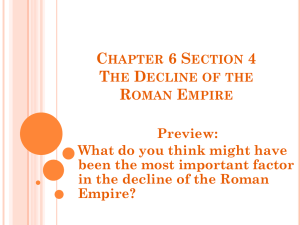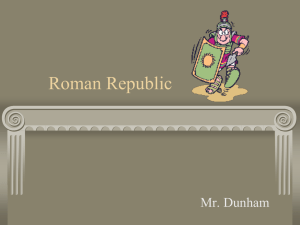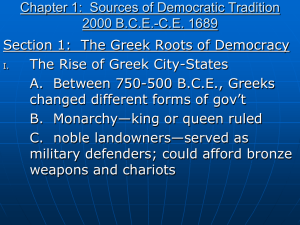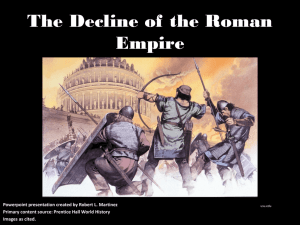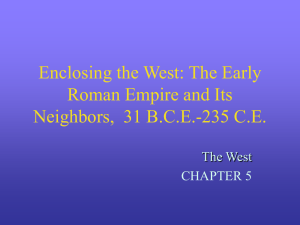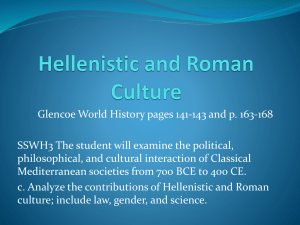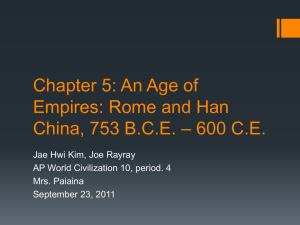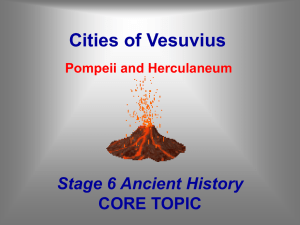Rome in the Golden Age
advertisement
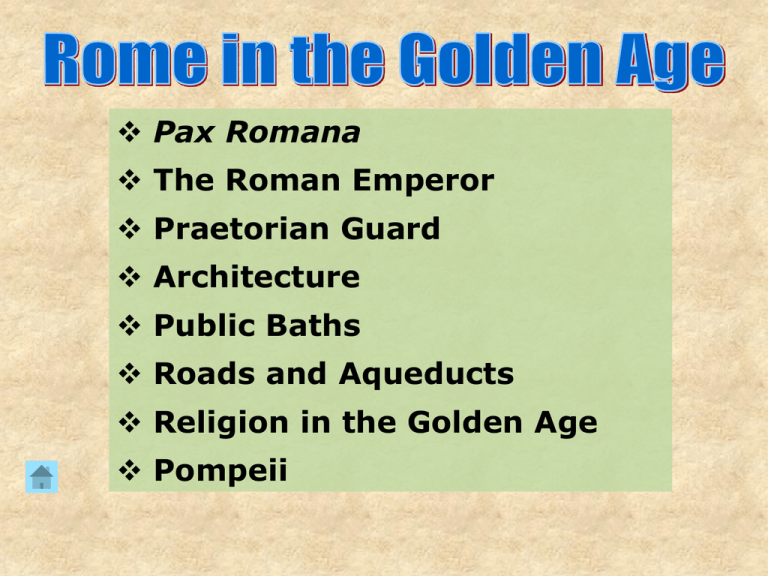
Pax Romana The Roman Emperor Praetorian Guard Architecture Public Baths Roads and Aqueducts Religion in the Golden Age Pompeii The Pax Romana The two centuries from the reign of Augustus until the death of Marcus Aurelius are known as the Golden Age of Rome, or the Pax Romana (Roman Peace). Although there were rebellions and wars of conquest in this period, the core of the empire enjoyed peace and prosperity. Market in Pompeii, by Antonio Niccolini The Roman Emperor In ancient Rome, there was no such title or office as “emperor.” The term “Roman emperor” is a convenient term to describe the single man who, from Augustus on, had all of the power that had been shared by many officers in the Republic. Emperors used a number of titles: Imperator (commander), princeps (first senator), augustus (venerable), and caesar. Praetorian Guard Created during the late Republic, it was an elite squad assigned to guard the commander’s tent. Augustus transformed the Guard into the emperor’s private army, which served as the police force in Rome and other Italian cities. It had legionary strength. A third of its members were stationed in Rome, where they dressed as civilians but carried weapons. Members of the Guard were paid 50% more than legionaries of comparable rank. In modern times, the term has been used to describe an elite military force protecting a dictator. The Praetorian Guard was an important force in the Principate. It could put an emperor in office, keep him there, or get rid of him. The Guard was weakened by Diocletian and eliminated by Constantine in the early 4th century. Praetorian Guard hails Claudius as emperor. Architecture In imperial Rome, architecture was a form of propaganda. Throughout the empire, great buildings, public and private, were a testament to the glory and importance of Rome and the emperor. As with military organization and weaponry, in architecture the Romans were great innovators. Arches, columns, domes and concrete, known and used by others, became something new and different in Roman hands. The Pantheon, one of Rome’s most famous buildings While stands the Coliseum, Rome shall stand; When falls the Coliseum, Rome shall fall; And when Rome falls - the world. - Lord Byron, Childe Harold's Pilgrimage The Colosseum, originally known as the Flavian Amphitheatre, was the largest amphitheater ever built in the Roman Empire. It held 50,000 spectators. Construction began around 70 under Vespasian and was completed in 80 under Titus. It remained in use for 500 years. The Colosseum was used for gladiator games and other public spectacles, including mock naval battles, for which it could be filled with water piped from the Tiber River. Medieval map of Rome showing the Colosseum Artist’s reconstruction of the Roman Forum in the Golden Age Public Bathing in Ancient Rome Public bathing was an important part of Roman social life in the Golden Age. Baths of Caracalla Sir Lawrence Alma-Tadema, 1899 A visit to the baths was a part of daily life for Romans. The baths were a place to relax and meet with friends. Women and men of all classes used the public baths. Sometimes there were separate facilities or hours for women; sometimes men and women bathed together. A trip to the baths would include exercise to work up a sweat, a soak in warm, hot and cool pools, and a cleansing massage with a strigil (pictured) which was used to scrape off aromatic oils and accumulated dirt. The Romans did not use soap. Roman baths ranged from small privately managed facilities to large public complexes built and operated by the state. Baths were found in every neighborhood of Rome, and in almost every Roman settlement throughout the empire. Baths of Caracalla The Caracalla baths, the second-largest bath complex in ancient Rome, included two public libraries, one with texts in Greek and the other Latin. Baths of Caracalla, engraving, Giovanni Battista Piranesi (1720-1778) Roads and Aqueducts Long straight roads, 53,000 miles of them, connected all parts of the Roman Empire to regional centers and the imperial capital in Rome. Roman road in Pompeii Photo by Paul Vlaar The roads were used: By legions to march quickly to where they were needed To transport goods over great distances By Romans to travel around the empire Via Appia – The Appian Way The roads were built to last; some are still used today. The roads were important for maintaining the stability of the empire. Later, during the 5th century as the empire collapsed, they were used by “barbarians” invading Roman provinces. Roman roads in Italy The arcades of the Aqua Claudia with the Anio Novus on top, two of the aqueducts of Rome. (Constructed in 36-50 under Caligula and Claudius) Photo by Wilke Schram www.romanaqueducts.info Aqueducts The Roman waterway system, which brought fresh water to private homes as well as public baths and fountains, was one of the engineering marvels of the ancient world. The Romans also developed indoor plumbing and sewers to carry waste away from homes. Clay pipes (lower right) tapped into Aqua Claudia Photo by Wilke Schram Eleven water lines brought water to Rome from sources as far as 60 miles away. Most of the system was composed of underground pipes and tunnels, but when the pipes had to cross valleys, or as they approached the city, they were raised on spectacular arched aqueducts. Covered stone water channel, Germany Photo by Wilke Schram The entire system was gravity-fed. Very subtle gradients maintained the flow of water. Occasionally, a system of pressurized pipe, called an inverted siphon, was used to push the water a short distance uphill. Similar aqueducts were constructed all over the empire. Some are still in use today. Roman aqueduct, ca. 19 BCE, Pont du Gard, France Religion Romans worshipped their classical gods as well as past emperors, deified after death. Emperor worship - the cult of the emperor became a unifying force in the empire. Temple of Augusta and Livia, Vienne, France. Erected by Claudius. Animals being led to sacrifice Emperor Marcus Aurelius offers a sacrifice Foreign Gods and Cults Cults from the east became popular in Rome. Mithras Mithras came to Rome from Persia, through Greece. Isis, a goddess of Egypt, was also popular in Rome. Many other “mystery cults” were popular in the empire. Isis Jews in the Empire Jews were a large religious minority in the Roman Empire. In addition to their kingdom of Judaea, there were many Jews in Egypt, Syria, and Greece. Josephus was a Jewish military leader who was captured by the Romans. He wrote a history of the JewishRoman War of 66-73. There was a Jewish community in Rome from at least the 2nd century BCE. Caesar and Augustus passed laws protecting the rights of Jews in Rome. Judaea had been a Roman ally since the 2nd century BCE. It became a province in 6 CE. Jews were usually treated with toleration and respect, but not always. Emperor Caligula insisted on placing a statue of himself in the temple at Jerusalem. Although he was killed before he could do so, he created resentment. In 66, a local conflict erupted into a major rebellion that lasted until 73. The Jews were defeated. Jewish deaths in the rebellion are estimated to have been between 600,000 and 1.3 million; 100,000 Jews were taken as slaves to Rome. The temple at Jerusalem was destroyed. 960 Jewish rebels made their last stand at the hilltop fortress of Masada. The Roman siege of Masada is one of the most famous examples of siege warfare. 15,000 Roman soldiers surrounded the fortress, preventing supplies from getting in. They constructed a massive ramp to assault the rebels on the hilltop. Rather than face capture, the rebels committed mass suicide. “From one end of Galilee to the other there was an orgy of fire and bloodshed." - Josephus, Jewish historian Masada and ruins on summit Titus, military commander in Judaea and later emperor, condemned 2,500 Jews to fight wild beasts in the amphitheater at Caesarea in celebration of his brother Domitan's birthday. Coin issued by Jewish rebels during the RomanJewish War Early Christianity Christianity began as a small cult – one of many – which grew in Palestine after the crucifixion of the Jewish teacher, Jesus of Nazareth. Communities of Christians developed around the Mediterranean. Many Christians differed widely on theory and practice. Christianity drew a following among the poor and uneducated. The empire was generally tolerant of religious practices, but Christians’ refusal to participate in official religious celebrations, and their practice of meeting in secret, drew public suspicion. Christianity grew slowly in the 1st and 2nd centuries. There were occasional episodes of persecution, as when Nero blamed Christians for the Great Fire of Rome. Christianity spread more rapidly in the 3rd century, along with political and economic disruption. Spread of Christianity to 325 CE The persecution of Christians also increased in the 3rd century crisis. Spread of Christianity to 600 CE Pompeii Pompeii, a city in southern Italy near Naples, was founded in the 6th century BCE. It was destroyed on August 24, 79 CE, when Mt. Vesuvius erupted, burying the city under several feet of ash and rock. Pompeii, buried in the explosion, was abandoned and forgotten. Computer-generated depiction of the eruption of Vesuvius (by the BBC) Ruins of Pompeii Photos by Robert Curtis Rossetti Pompeii was rediscovered in 1748. Excavations have exposed a wellpreserved Roman city from the Golden Age. Below you will find the Table of Contents for the Ancient Rome PowerPoint. If you are connected to the internet, click on the link below to go directly to the Ancient Rome page: Ancient Rome PowerPoint Rome and the Ancient World Roman Republic Roman Expansion/Punic Wars Roman Society in the Republic The Roman Revolution The Principate Rome in the Golden Age Third Century Crisis The Dominate Late Antiquity Legacy of Rome Slide Slide Slide Slide Slide Slide Slide Slide Slide Slide Slide 4 31 46 82 126 159 191 229 244 257 282




